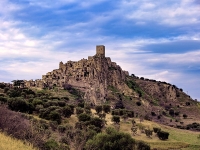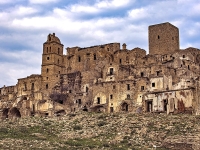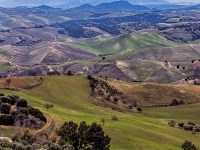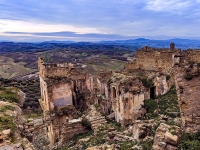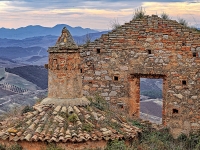Travel
CRACO The Ghost Town
Craco Basilicata Italy
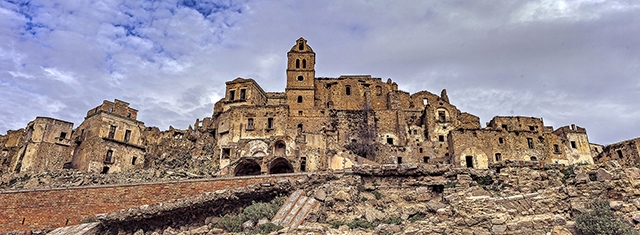
CRACO The Ghost Town (Source: Roberto Magni by Foto ReD Photographic Agency)
USPA NEWS -
Craco is a ghost town and comune in the province of Matera, in the southern Italian region of Basilicata. It was abandoned towards the end of the 20th century, due to faulty pipe work that was thought to have failed, causing the town to be abandoned due to a land slide. The abandonment has made Craco a tourist attraction and a popular filming location. In 2010, Craco was included in the watch list of the World Monuments Fund.
Mother Nature had more in store for Craco. Poor agricultural conditions caused a severe famine in the late 19th century. This spawned a mass migration of the population about 1,300 people to North America.
Mother Nature had more in store for Craco. Poor agricultural conditions caused a severe famine in the late 19th century. This spawned a mass migration of the population about 1,300 people to North America.
Then came more landslides. Craco had a series of them plus a flood in 1972 and an earthquake in 1980. Luckily, in 1963, the remaining 1,800 inhabitants were transferred down the mountain to a valley called Craco Peschiera.
The origins of the town are very ancient and the first evidence dates back a primitive settlement up to the eighth century BC. The great urban development of the locality took place, however, in the Middle Ages under the influence of the Byzantines, first, and then the Normans. The development of agriculture in the area is due to the former, and in particular to a monastic order established here: the name of Craco probably derives from this circumstance, from Graculum which means "small plowed field".
When the region passed under the Norman dominion, the center developed into the village, especially after the establishment of the fief of Erberto (between 1154 and 1168), becoming, under the reign of Frederick II, an important strategic center, as confirmed by the erection of the Torre di Craco (which allows you to dominate the course of the Cavone and Agri rivers). The development of the town continued in the following centuries, with the construction of numerous noble palaces, such as Palazzo Maronna and Palazzo Grossi.
In the twentieth century, after the turbulence of the post-unification period, Craco continued quietly in his life as a small rural center, mainly interested in keeping his distance from the events that concerned the rest of Basilicata and Italy. Although affected until a few years after its "end" by intense land ownership, the agricultural production of Craco was among the most flourishing in the entire region, to the point of guaranteeing the town the nickname of "Country of wheat". Close to the 1960s, so much wheat was produced that the approximately 2,000 inhabitants were unable to cope with the cultivation needs of the immense lands of the local noble families, having to request the contribution of laborers also from Salento.
Paradoxically, the onset of discontent over the redistribution of land to small farmers, which would have led to the end of land ownership - which finally came with the agrarian reform of the mid 1960s had one of its main manifestations in Craco, as can be deduced from a poster in red still visible today on the facade of Palazzo Grossi, which manifests the requests of the peasants: "Bread and work". In fact, the redistribution of the land took place just before the landslide of 1963, which completely revolutionized the history of the town.
The phenomenon, probably due to errors in the design of the water system, involved a long process of disintegration of the soil on which the houses stood, endangering the inhabitants. A process that could have been stopped at the time, creating terraces with trees to stop the subsidence, but which, instead, was dammed with fragile retaining walls, which soon proved useless. Thus, for about ten years the slow exodus of the people of Craco began, until the complete abandonment of the town in 1974.
Considering that the land did not cease its constant decline, it was decided to forcibly transfer the inhabitants, assigning them social housing in the downstream locality, Peschiera, near Pisticci, which represents the major center of the area. This has generated a lot of discontent in the people of Craco, who did not consider the idea of living in the "New Craco" badly. This is testified, moreover, by the fact that the current municipality was unable to reduce the diaspora of its inhabitants: in 2017, in fact, the census counted just 730 people.
Not everyone was willing to move, however. One man native to the tiny town resisted the relocation, choosing to live the rest of his more than 100 years in his native land.
Even though Craco is eerily uninhabited, it springs back to life during the religious festivals held there every year. These festivals mainly pay homage to the Virgin Mary (an ancient statue of her was discovered in nearby waters) and San Vincenzo - the martyred patron saint of the town.
Hollywood occasionally features Craco's crumbling ruins in some films. They provided the backdrop for scenes of the 2004 movie The Passion of The Christ and the James Bond flick Quantum of Solace in 2008.
more information: https://www.redmagazine.red
Liability for this article lies with the author, who also holds the copyright. Editorial content from USPA may be quoted on other websites as long as the quote comprises no more than 5% of the entire text, is marked as such and the source is named (via hyperlink).

